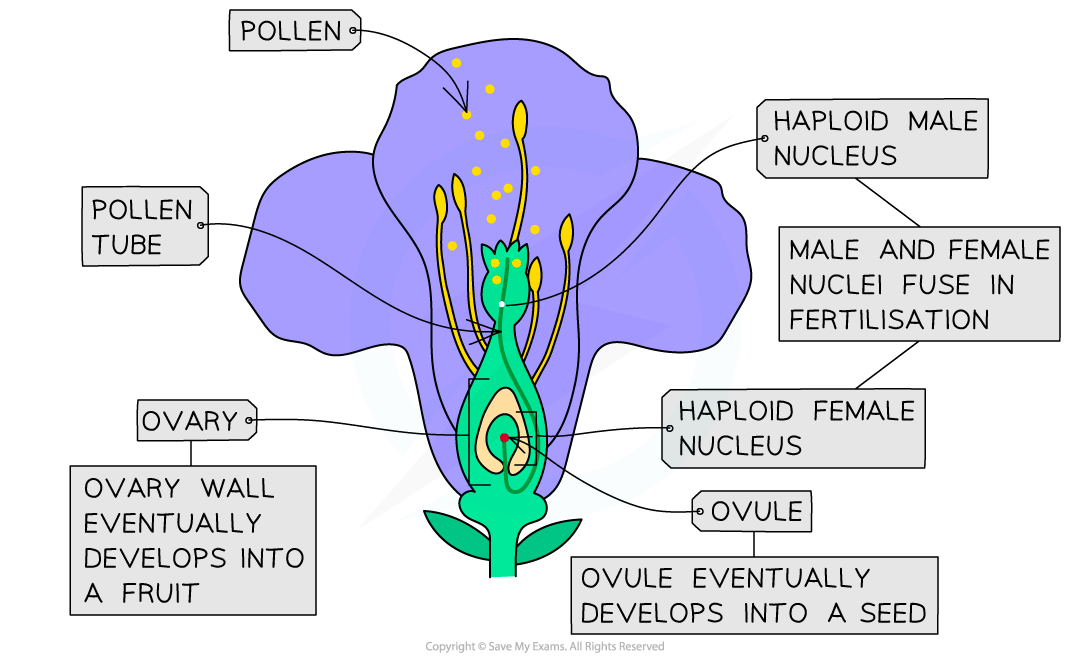Mutualism Between Flowers & Pollinators
- Sexual reproduction in plants requires the transfer of pollen between flowers
- Methods of pollen transfer can include:
- Wind
- Animals
- Water
- Most flowering plants use mutualistic relationships with animal pollinators in sexual reproduction
- The pollinator visits the flower to obtain food, often in the form of nectar, from the plant
- Pollinating animals can be insects, birds, or small mammals such as bats
- Pollen sticks to the body of the animal and is subsequently transferred to the flowers of the next plant visited by the pollinator
- It is a mutualistic relationship because both organisms gain a benefit during the process
- Mutualism is a type of symbiotic relationship
- Mutualism relies on repeated interactions, sometimes between one species and several others
- An example is a bee that will visit, feed on the nectar from and pollinate many species of flower
- Symbiosis relies on two species remaining in partnership exclusively to each other
- The pollinator visits the flower to obtain food, often in the form of nectar, from the plant
Pollination, Fertilisation & Seed Dispersal
Introduction to Flower Structure
- The development of flowers occurs in the reproductive stage of the plant life cycle
- Flowers contain all the necessary organs and tissues required for sexual reproduction by pollination
- Key structures of the flower include
- The anther - where the male gamete, pollen, is found
- The stigma - part of the female reproductive organ which receives the pollen
- The ovary - where the female gametes are located

Animal pollinated flowers have structures that attract pollinators and aid the process of pollination
Pollination and Fertilisation
- Pollination is the process of transferring pollen from the anther of one flower to the stigma of another
- Self pollination can occur in some species when pollen is transferred between different flowers on the same plant, or even from anther to stigma within the same flower
- After pollination has occurred, a pollen tube grows from the pollen grain down the style to the ovary of the plant
- The male nuclei travel down the pollen tube to the female ovule
- Two male nuclei travel down the pollen tube to the ovule; one will fuse with an ovule nucleus to form the zygote while the other will go on the form the plant embryo's food store
- Fertilisation occurs when the haploid male and female nuclei fuse and a diploid zygote is formed
- After fertilisation, the ovule becomes a seed and the ovary develops into the fruit

After pollination the haploid male and female nuclei can fuse in fertilisation to make a diploid zygote
Seed Dispersal
- Seed dispersal is then required in order to distribute the seeds away from the parent plant and reduce competition between the offspring and the parent plant
- Methods of seed dispersal include
- Wind or water
- Parachute or wing shaped lightweight seeds will travel on the wind or float in water
- Animals
- Fleshy fruit is eaten by animals and seeds distributed through egestion
- Sticky or hooked seeds catch on to the fur or feathers of passing animals
- Explosions
- Some pods explode propelling the seeds away from the parent plant
- Wind or water
- Methods of seed dispersal include
Exam Tip
Be careful not to mix up pollination and seed dispersal; pollination is the transfer of pollen from anther to stigma, while seed dispersal is the distribution of mature seeds. Both processes can involve wind, water, or animals.
Protecting Pollinators
NOS: Paradigm Shift; more than 85% of the world’s 250,000 species of flowering plant depend on pollinators for reproduction. This knowledge has led to protecting entire ecosystems rather than individual species
- Paradigm shifts occurs when frameworks underlying scientific thinking change due to e.g.
- Discovery of new knowledge
- Developing understanding
- Updating processes as a result of changed knowledge and understanding can allow progression towards more successful approaches in science
- A shift in the approach to conservation is an example of this:
- Early efforts in conservation were primarily focused on protecting individual species or populations which were under threat
- However, whilst it is still essential to promote the maintenance of animal populations over time, it has become apparent that the relationships between species and the ecosystems in which they live are just as fundamental, if not more so
- With this in mind, it is important to conserve habitats and the ecological processes relied on by the communities within those habitats
- The role of pollinators is a key example of a relationship between species and ecosystem where changes in the process of pollination could have huge impacts on the wider ecosystem
- Pollinators directly support the survival of plant species with which they interact, and also indirectly impact the other species within the associated community
- Loss of either pollinator or plant species could cause an ecosystem to break down, leading to huge biodiversity losses
- Pollinators play a huge role in the production of crops and therefore are relied upon by the farmers growing those crops for an income, but also by the consumers of the crops who require affordable and good quality food sources
- Pollinators directly support the survival of plant species with which they interact, and also indirectly impact the other species within the associated community
